The Achilles tendon is made of five tendons; however, the gastrocnemius tendon and the superficial digital flexor tendon are most important. The gastrocnemius tendon is most commonly torn. The typical sign of a gastrocnemius tendon tear is a partially dropped hock and curling of the toes. Surgical treatment involves repairing the tendon and supporting the limb in a cast for about 2 months
Anatomy
- The Achilles’ tendon is made of five tendons; four of these tendons attach to the heel or calcaneous bone and one goes over the back of the heel bone to the toes of the hind limb – see diagram below – “Normal”
- Components of the Achilles’ tendon
- Gastrocnemius tendon – the main tendon that attaches to the heel or calcaneous bone
- Superficial digital flexor – second main tendon that partially attaches to the calcaneous bone and then passes over the end of the heel bone and attaches to the digits; this tendon flexes the digits
- Three minor tendons
- Achilles’ tendon ruptures can be partial or complete

Clinical signs
 Partial rupture
Partial rupture- Usually involves rupture of the gastrocnemius tendon and not the superficial digital flexor
- Dropped hock
- Curled toes (called a bear claw stance) – see middle diagram above – “Gastroc tear only”
- Lameness
- The reason that the toes curl with a partial rupture is that the superficial digital flexor tries to keep the heel elevated; the result is that tension is exerted on the toes causing them to curl
- In the photo right take note of the toes in a dog that has a gastrocnemius tendon tear
Complete rupture
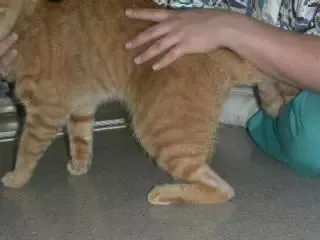
- The pet will have a completely dropped hock (see far right diagram above – “All tendons torn”) so that he/she walks a human instead of on tippy toes like a dog/cat should
- Lameness
- In the photo right, this cat is displaying a typical stance (dropped hock) due to a complete Achilles’ tendon tear. The tendon was lacerated by a broken flower vase.
Diagnosis
Physical examination findings
- Radiographs (x-rays) to rule out fracture or other diseases
- Ultrasound of the tendons
- MRI of the tendons
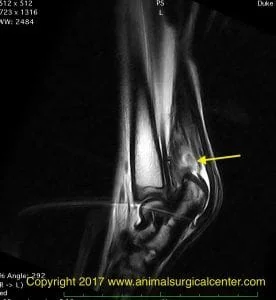
The arrow points to a bright spot in the very thickened Achilles tendon which is called a “core” lesion due to tearing of the tendon.
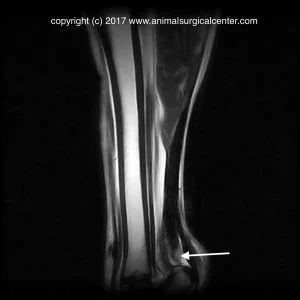
T2 MRI sagittal view of the Achilles tendon. Take note of the top arrow which is pointing to the area of fluid accumulation within the tendon and disruption of the fibers (myotendinous tear). The bottom arrow shows the torn end of the gastrocnemius tendon off the calcaneous bone.
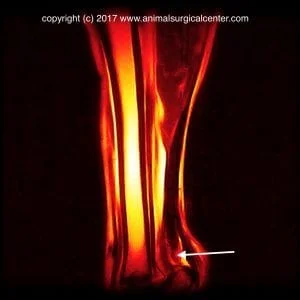
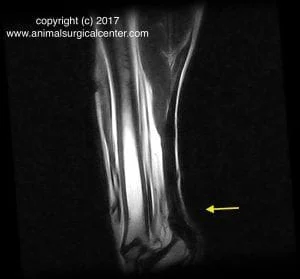
T2 MRI sagittal view of the Achilles tendon. Take note that the tendon is thicker than normal with mild wispy fluid accumulation within the tendon. This tendon is intact, but the dog still had a dropped paw. The cause of the dropped hock was due to tearing of the gastrocnemius muscle head near the stifle (knee).
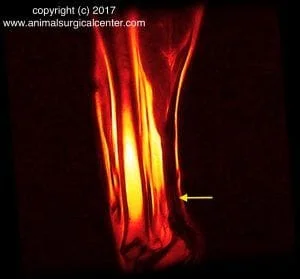
Treatment
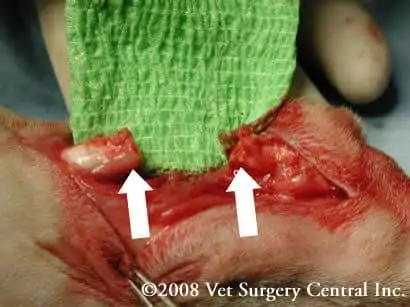
- Surgery is usually recommended
- Splinting and platelet-rich plasma or stem cell injection can be used if a minor tear is present
- Surgery
- Photo on right of a torn Achilles’ tendon in the cat seen above
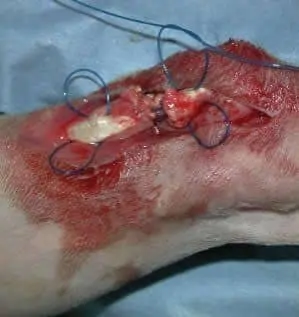
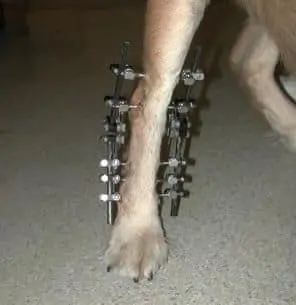
- The tendon repair must be supported for 2 months
- This support is provided by
- a cast
- a trans-calcaneotibial screw and cast
- an external skeletal fixator which consists of pins that go through the bones and are supported by bars (see photo)
- This support is provided by
Potential complications
- Pressure sores from the cast
- Infection
- Breakdown of the repair
- Anesthetic death
Aftercare
- Restriction of activity for 3 months to the house; keep on a leash when going outdoors for elimination purposes only
- Hock or ankle joint is kept in extension to keep pressure off of the tendon repair for a minimum of 2 months
- Cast care if this is used for additional support
- Place a plastic bag on cast when dog goes outside and remove when back inside
- The inner padding of the cast needs to be changed every two weeks
- Watch for signs of pressure sores which may include the following:
- dog is paying more attention to cast… i.e. is trying to chew cast off or licking at cast
- foul odor from cast
- discharge coming through the cast
- External fixator care if this is used for additional support
- Clean around pin sites daily using a Q-tip and hydrogen peroxide until the skin has healed around each pin and no more discharge is produced
- Daily apply Neosporin to each of the pin entry sites until the skin is healed around the pins
- Pack the skin down the pins using foam sponges
- Wrap the external bars with an Ace bandage
- Antibiotic should be administered if prescribed
- After two months, the cast or the external fixator is removed and a soft padded bandage will be applied for an additional 2 weeks


